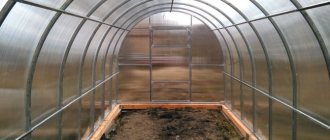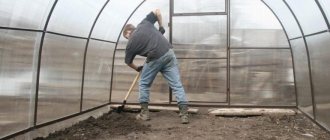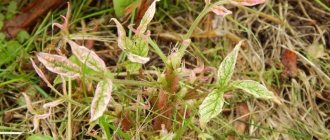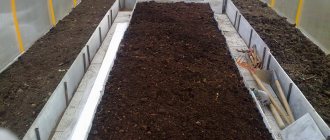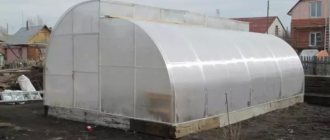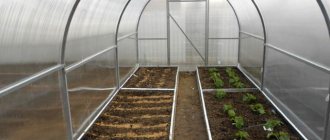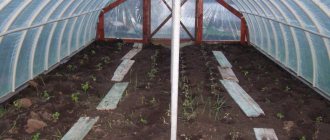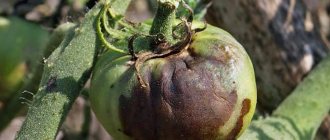After harvesting vegetables, it is necessary to include sanitary treatment of the polycarbonate greenhouse in the autumn in the schedule of activities. During the last rotation, harmful bacteria, viruses, harmful insects and fungi, which can safely overwinter under a layer of snow and plant debris, could accumulate and multiply in the cultivation room. With the onset of spring, they will come out of their hiding places and begin to attack cultivated plants.
In order to prevent the mass reproduction of pests and pathogenic microorganisms, in the autumn a set of measures is carried out to clean and disinfect protected ground structures. Based on the advice and recommendations of experienced gardeners, we have put together all the information on how such work should be carried out.
Preparing the greenhouse for processing
Cleaning
Everything had to be removed from the greenhouse in the fall, leaving empty walls and empty beds inside. However, situations are different. If autumn cleaning was missed, it will have to be done in early spring.
All used equipment is disinfected or destroyed:
- pegs, supports, trellises, racks, etc.,
- ropes, twines, garters, etc.,
- irrigation systems,
- shovels, rakes, scoops, rippers, etc.
How to disinfect? Metal parts are washed with Bordeaux mixture, wooden parts are treated with slaked lime or ordinary bleach.
All plant remains from last year must be disposed of. Ideally, they are burned.
Checking the condition of the greenhouse
The first stage of preparing a structure for spring planting is checking its condition after wintering. Even a greenhouse that is properly prepared for winter can suffer some damage over the long cold months without constant supervision.
Both all frame parts and the coating itself need to be checked. Before proceeding directly to processing, all damage must be corrected.
Main stages
If you neglect to disinfect the polycarbonate greenhouse, then harmful bacteria will again infect the planted crops in the new season. It is known that many pathogenic pathogens do not lose their activity for a long time. This refers to late blight spores that destroy tomatoes. Autumn treatment of a polycarbonate greenhouse can effectively eliminate whiteflies, aphids, spider mites, nematodes and other parasites.
It is recommended to perform all work in the following order:
- collect and remove all plant remains from the greenhouse;
- wash, clean the walls and roof of the greenhouse;
- perform soil processing and preparation;
- carry out disinfection;
- if necessary, make minor repairs to the structure.
Advice!
The best time to carry out disinfection work is when the air temperature is 10-15o plus. It is necessary to remove all pegs and garter material from the greenhouse, as well as tools and shelving. If polycarbonate is removed in the structure, then it is better to remove the coating.
How to clean a greenhouse in spring, inside and out
Cleanliness is the key to health. This statement is as true for plants as it is for people. If the greenhouse was washed in the fall, then in the spring there will be much less hassle. All that remains is to update the result: go over all the details of the coating with clean water using a regular rag. You can also use an electric sprayer charged with clean water or a washing system, if available.
Polycarbonate requires tenderness! Washing a greenhouse made of cellular polycarbonate should be done carefully, using microfiber cloths or soft sponges. This will prevent scratches and cracks. The water pressure in the washing station when using it should be minimal.
How to wash a greenhouse in the spring if it has been dirty for the winter? Ordinary soapy water is best suited for these purposes (it is better to use laundry soap or special garden soap). You can add a drug to the water against a particularly annoying disease or pest from last season, if there were any.
First, you can go through the greenhouse inside, then outside, leaving the foam on the surfaces for at least 10 minutes. Just when you've finished washing the outside, it's time to go back inside. In the same sequence, rinse all surfaces clean. When washing inside, you should be careful so that the soap solution does not fall on the ground.
Advice! Before you start wet cleaning, dry clean to remove dust and dirt. Then washing will be faster and easier.
How to wash a greenhouse with a washing station
Stage #2 – garbage collection and disposal
It is absolutely necessary to remove last year’s pegs, pieces of twine used for tying cucumbers or tomatoes and other disposable devices. Definitely, the roots of bushes that have completed fruiting should not remain in the soil, nor should their stems and leaves remain on the surface. It is not difficult to guess the fate of the weeds. Although, according to unspoken greenhouse rules, they are removed along with the remains of cultivated plants in the fall.
All greenhouse waste, including rotted wooden parts from repaired structures, must be burned. Moreover, the resulting ash will serve as an excellent mineral fertilizer. And the good news is that the soil can be enriched with potassium, magnesium, sulfur, iron, calcium, phosphorus, etc. absolutely free of charge. Only there will be no nitrogen in this homemade fertilizer, because it evaporates when burned.
Suitable for burning waste:
- homemade stove made from a metal barrel without a bottom. Its construction begins with the installation of brick pillars, on which a metal grating is first placed, then a barrel is erected. The draft is excellent, sparks do not scatter, and an improvised grate will ensure accurate collection of ash;
- a site with a dirt or other non-flammable surface with a diameter of 3-4 m, cleared of dry grass and wood; paper scraps. There should be no stains of spilled gasoline, diesel, kerosene or other fuel on it;
- an open fireplace lined with bricks, for the manufacture of which you can take broken or defective material.
Ash will require 3-5 cups per 1 m² if it is applied dry as fertilizer. Scatter it before digging. If ash is used for feeding, dissolve one glass of dry matter in a bucket of water.
Disinfection of a greenhouse in spring
It will be necessary to disinfect the greenhouse surfaces in the spring only if the autumn stage was skipped. If all the work has been completed in full, only washing will be enough in the spring.
Recipes for disinfectant solutions for treating polycarbonate greenhouses will not differ from those for glass. But for frame parts you should choose the appropriate processing method; it will depend on the material.
Solutions for disinfecting coatings
- A weak solution of Bordeaux mixture or ready-made Bordeaux mixture.
- A solution of a biological product against fungi and pests (Fitop-Flora-S or analogues).
- A solution of potassium permanganate in hot water.
- A decoction of pine needles or nettles (pour half a bucket of herbal ingredients with water and cook for 20 minutes).
- A strong solution of mustard powder.
Any of the selected options must be poured into the sprayer container and generously treated with it all surfaces from the inside of the greenhouse. Pay special attention to joints and cracks.
Disinfection of greenhouse surfaces with potassium permanganate
Frame disinfection solutions
Metal or plastic - apply a solution of Bordeaux mixture. Galvanizing - apply a 9% vinegar solution. Wood - whiten with a thick solution of slaked lime at the rate of 3 kg of lime per 10 liters of water (you can additionally add 0.5 kg of copper sulfate to the solution).
Note! If fungal stains are found on wooden structures, first of all, you need to thoroughly rinse these areas with bleach. Then dry. Only then whiten it.
Fumigation with sulfur bombs
Treating a greenhouse with a sulfur bomb in the spring is an unacceptable undertaking for most modern gardeners. Judge for yourself! Firstly, when a bomb is burned, sulfur dioxide is formed, which will invariably end up in the soil. Secondly, fumigation is ineffective against the most common greenhouse diseases: bacteriosis, downy mildew and the ubiquitous late blight. Thirdly, to carry out chemical treatment with sulfur you need to wear a chemical protection suit (it’s a big problem for an ordinary summer resident to get one). And finally, fourthly, this treatment is not suitable for greenhouses with a metal frame, because it will be subject to destruction.
Fumigation with tobacco sticks
An excellent option for disinfecting all types of greenhouses from wintering insect pests. Using such checkers, you need to carefully calculate the required quantity for each specific greenhouse. Before use, you need to check the structure again for leaks. From a greenhouse with cracks and holes, the smoke will evaporate and will not reach the required concentration, which means the desired effect will not work. Before use, carefully read the instructions and follow their instructions.
Frame and coating processing
The frame to which the polycarbonate is attached is carefully inspected for rust and other damage. The rust is removed and the cleaned area is painted over. Any structural damage found is repaired.
All frame elements are washed with warm soapy water. The greenhouse is processed in the fall or spring, both inside and outside. Then the soap solution must be removed with a damp cloth. This must be done carefully, avoiding soap getting into the soil. To process polycarbonate, use only non-abrasive detergents and rags or soft sponges to avoid damaging the coating.
How to disinfect soil in a greenhouse
Disinfection of soil in a greenhouse in the spring is fundamentally different from similar treatment in the fall due to the impossibility of using chemicals. And here we are talking not only about complex treatment with formaldehyde, but also about the usual application of copper or iron sulfate, Bordeaux mixture and other chemicals against diseases and pests. Using all of the above to disinfect the land can negatively affect the well-being and growth of crops planted later.
If autumn soil disinfection was not carried out, do not despair. There are more gentle options for cultivating the soil in a greenhouse in the spring, so as not to harm future plantings.
Soil freezing
Suitable if you realized about the missed treatment in winter, before the temperature rose above -15 °C. All doors and windows in the greenhouse open. Snow is falling inside.
Steaming the soil
The soil in the greenhouse is poured with boiling water (3 buckets per square meter). After this, the surface is covered with thick plastic film and left alone for a couple of days.
Disinfection with potassium permanganate or nitrophen
The soil is spilled with a solution of potassium permanganate (1%) or nitrophen (3%). The event is held at least 15-20 days before planting the plants in the greenhouse.
Treatment with biological agents
The most popular biological products:
- Fitosporin,
- Economist is productive,
- Trichocin,
- Trichoplant,
- Fitop-Flora-S.
Tilling the soil in a greenhouse in the spring before planting with biological preparations will only be effective if used on sufficiently warm and moist soil. In order for biological agents to act as stated, the temperature of the soil (not the air!) must be at least +14 °C. In addition, after treatment it is necessary to maintain its moisture by periodically watering.
The process itself is not complicated. The selected product is diluted in water according to the instructions. The soil in the greenhouse is generously spilled with the resulting solution. In principle, there can be no overdose here. After watering with the chosen product, you need to pour it just as generously with plain water. The surface is covered with film (to reduce evaporation and maintain humidity) and left for at least 14 minutes.
Disinfection of the soil with Fitop-Flora-S must be carried out twice before planting. With a waiting period after each treatment of 14 days.
Ready-made chemicals that can be used to treat a greenhouse
Let's list:
- Fufanon is effective in the fight against aphids, whiteflies, thrips and spider mites. Add 5 ml of the product to 5 liters of water, and use the resulting solution to spray cracks in the frame, fences of beds, other places where insects can overwinter, and the top layer of soil.
- Thunderstorm - effectively fights slugs and snails. This product is sprinkled on the soil immediately after the plants have been removed from it. There should be 15 grams of the drug per 5 square meters. There is no point in cultivating the land with it when the cold weather has already set in.
- Muracid is an excellent remedy for fighting ants. It is sold in ampoules of 1 ml. It needs to be diluted in 10 liters of water and used to water the nests. You need to pour 1 liter of solution onto each nest. You can also use this solution to water ant paths.
- Thunder - used in the fight against mole crickets and ants. At mole cricket burrows with a diameter of up to 2 cm, lay out the preparation, slightly moistening it. For each hole there should be 1 teaspoon of the drug. When fighting ants, the product is sprinkled onto their nests.
- Marshall - used to control nematodes, aphids, thrips and spider mites. One ampoule of the drug (7 ml) is diluted in 9 liters of water. The resulting solution is watered over an area of 10 square meters. Only one such treatment can be carried out in one season. The product is toxic to both humans and animals.
- Fitosporin is a biological drug used against fungal diseases. Pour 5 grams of powder into 10 liters of water and mix. The solution is used to spray the ceiling and walls of the greenhouse, as well as the top layer of soil. The drug is active only at temperatures of +10 degrees and above.
Processing times
Typically, a greenhouse structure made of polycarbonate sufficiently protects the interior space from external pollution, so many gardeners do not consider general cleaning of the greenhouse important before the start of the new planting season. In fact, preparation can change everything for the better.
The main principle for choosing the timing of treatment is based on the fact that it is necessary to clear the room of pests at the moment of their transition to the active phase of life. To do this, individuals and their larvae need time and a favorable temperature regime to wake up. The effectiveness of processing soil that has not yet thawed is reduced to zero.
If treatment with chemicals is planned, it is best to carry out it after a layer of soil 10 cm deep has thawed. It is important to maintain an interval between treatment and planting. It is better if it is at least 10 days before the planned planting of crops in the greenhouse.
The soil must be treated several weeks before planting seedlings and seeds. This is usually the period from late February to early March.
Rules of conduct and safety during disinfection
Most disinfectants are biologically active and aggressive substances, which in high concentrations or in direct contact can be harmful to human health. Therefore, it is necessary to strictly observe safety measures when processing greenhouses, greenhouses, vegetable gardens and garden plants. When using bulk preparations for disinfection, use anti-dust respirators; gas and smoke mixtures require the use of a gas mask, and liquid preparations require protective clothing, gloves and goggles.
During the processing of the greenhouse, you should not store gardening tools, various containers (especially wooden ones), partitions, wire and sticks for fastening in it.
Before entering, it is recommended to lay out a mat soaked in bactericidal compounds, copper sulfate, ammonium nitrate, and chlorinated lime.
Personal protective equipment when disinfecting a greenhouse with copper sulfate or other pesticides
When to treat
Treatment of the greenhouse in the spring should begin before the snow melts - it should be brought in and covered with it over the entire area of the soil. For initial procedures, its role cannot be overestimated. Benefits of using snow:
- melt water penetrates the soil, saturating it with useful microelements;
- Because of the snow, the ground freezes, which leads to the death of pests that have not yet awakened.
Attention! You can get rid of ice from polycarbonate if you open all windows and doors at sub-zero temperatures. When the temperature levels out, the crust will be easy to remove.
In the last winter month, the soil needs to be cleaned and disinfected. In addition, greenhouses need treatment. In particular, if wooden parts are rotten, then replacing them is impossible. Metal structures that have become corroded should:
- clear;
- treat to get rid of rust;
- apply primer;
- paint.
You can use folk remedies for these purposes.
